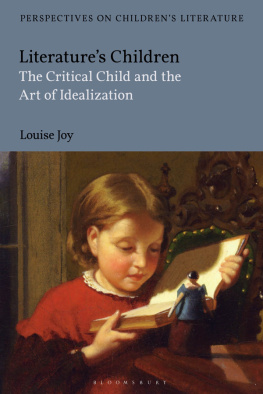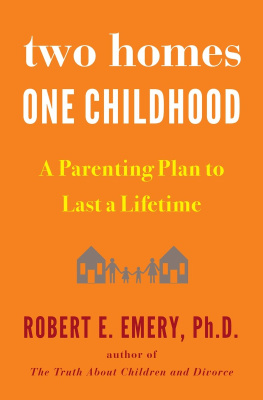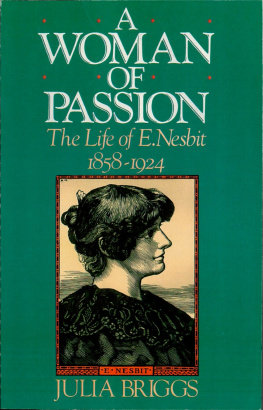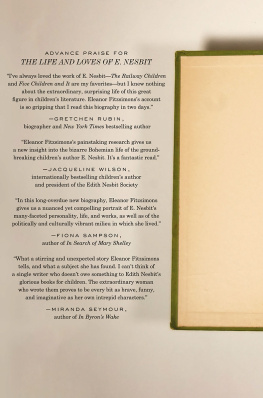The Extraordinary Life of E. Nesbit
This book is dedicated to my loving husband.
The Extraordinary Life of E. Nesbit
Author of Five Children and It and The Railway Children
Elisabeth Galvin
First published in Great Britain in 2018 by
PEN AND SWORD HISTORY
an imprint of
Pen and Sword Books Ltd
47 Church Street
Barnsley
South Yorkshire S70 2AS
Copyright Elisabeth Galvin, 2018
ISBN 978 1 52671 477 0
eISBN 978 1 52671 479 4
Mobi ISBN 978 1 52671 478 7
The right of Elisabeth Galvin to be identified as the author of this work has been asserted by her in accordance with the Copyright, Designs and Patents Act 1988.
A CIP record for this book is available from the British Library All rights reserved. No part of this book may be reproduced or transmitted in any form or by any means, electronic or mechanical including photocopying, recording or by any information storage and retrieval system, without permission from the Publisher in writing.
Pen & Sword Books Ltd incorporates the imprints of Pen & Sword Archaeology, Atlas, Aviation, Battleground, Discovery, Family History, History, Maritime, Military, Naval, Politics, Railways, Select, Social History, Transport, True Crime, Claymore Press, Frontline Books, Leo Cooper, Praetorian Press, Remember When, Seaforth Publishing and Wharncliffe.
For a complete list of Pen and Sword titles please contact
Pen and Sword Books Limited
47 Church Street, Barnsley, South Yorkshire, S70 2AS, England
E-mail:
Website: www.pen-and-sword.co.uk
Edith Nesbits Family Tree
Acknowledgements
The painstaking work carried out by Edith Nesbits two previous biographers Doris Langley Moore OBE and Professor Julia Briggs resulted in comprehensive archives of irreplaceable historical material that are invaluable to anyone writing about Edith Nesbit. Seven years after the author died, Mrs Langley Moore undertook, as a young writer who had recently moved out of London, the monumental task of documenting the life of a deeply unconventional woman. The fact that Mrs Langley Moore wrote some thirty letters alone attempting to uncover the reason for Hubert Blands conversion to Catholicism indicates her extraordinary commitment to research, and she admitted to putting her heart and soul into the project. Without her efforts, much of Ediths personal history would have been lost forever. Some of the facts that Mrs Langley Moore uncovered were thought inappropriate to be revealed so soon after Ediths death and were left out of E Nesbit: A Biography , which was published in 1933 by Ernest Benn (the publisher Edith shared). However, she revised her book thirty-three years later in 1966, to include a more complete picture of her subject. In the 1980s, she graciously gave her notes and contacts to help Professor Julia Briggs write a new biography a gesture that the always-generous Edith would have approved. The result was that Prof Briggs left no stone unturned in her unsurpassed biography A Woman of Passion , published in 1987 by Penguin Books. As a pioneer in the study of childrens literature, Prof Briggs conscientious research into Ediths life couldnt have been more comprehensive nor her analysis of her findings more intelligent.
Edith Nesbit was keen throughout her career to help up-and-coming writers, and as a first-time author, I found this deep generosity in abundance in Dame Jacqueline Wilson who so very kindly wrote the foreword to this book and also agreed to be interviewed. I will always be grateful for her support, encouragement and enthusiasm; she is an E. Nesbit for the twenty-first century. Similarly, Kate Saunders was the first person I interviewed for the biography and her great knowledge, passion and intellectual understanding of Edith Nesbit gave me the best start I could have asked for.
The warmth and friendship I have received from the Edith Nesbit Society has been invaluable, particularly the assistance of Margaret and Jerry McCarthy, Marion and John Kennett, Margaret Taylor, Maureen and Brian Speak, Bronwen and Ian Fair and Fern Ravandi, Edith Nesbits great-granddaughter who is an honorary member of the Edith Nesbit Society, www.edithnesbit.co.uk .
Special thanks must go to Jenny Agutter and Bernard Cribbins for very kindly being interviewed. Also, Mike Kenny, Caroline Harker and David Barron (along with Laura Elmes at Runway Entertainment) who were part of the production of The Railway Children at Waterloo Station and Kings Cross Theatre and generously agreed to speak with me after I saw the play in its last week in January 2017.
I would also like to thank the Biographers Club and I. Marc Carlson and staff at the Department of Special Collections, McFarlin Library, The University of Tulsa, Oklahoma, United States of America for their help with the Edith Nesbit Collection.
Further thanks must go to Jo Mahoney at Prendergast School; Niky Stonehill of StonehillSalt PR for her help with the chapter on Harry Potter; and to Tracey Grove for introducing us. Celia Catchpole of the Catchpole Agency very generously and conscientiously read through the manuscript and made invaluable suggestions, as did my friends including Elena Dalrymple, Georgina Wilczek and Kirsty Nancarrow. My greatest gratitude goes to my family for their enthusiasm, practical support and constant encouragement especially Bob and Helen Galvin, my husband Brad and my three young children Mary, William and Elsa. My warmest acknowledgement must go to my sister, Hayley Relph, who read the book twice before publication, and to my parents, Bert and Gay Attwood, who first read me The Railway Children and inspired my lifelong love of literature.
Foreword
Dame Jacqueline Wilson
Im delighted to be introducing a new biography of Edith Nesbit, my favourite childrens author. A handful of her wonderful books are still in print, even though theyre more than a hundred years old, and there have been television adaptations, films and stage shows but most people know very little about Edith herself. Perhaps its because all her childrens books called her E. Nesbit on the title page, a stark and sexless name that gives away nothing.
Theres a lot to be told about Ediths private life. Indeed, her first biographer, Doris Langley Moore, had to be very circumspect when recording her life, and Julia Briggs later called her own biography A Woman of Passion for definite reasons. As readers will discover in this lively concise account, Edith was indeed passionate, a Bohemian woman who led a highly unconventional life. She flouted all the social and moral rules of her time with delight. She had inappropriate affairs, wore daring clothes, and lost her temper spectacularly. She was a mass of contradictions: a feminist who didnt believe in votes for women; an extremely casual mother who still brought up her husbands illegitimate children as her own; a preposterously lavish hostess who served bread and cheese and lentils for supper with style when her money ran out.











